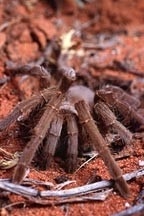-
Brazilian Black Tarantula
Scientific Name: grammostola pulchra This spider is striking in the simplicity of its appearance. The species is covered in short fine hairs giving it the appearance of velvet and is jet black in colour. It is not an aggressive tarantula but is somewhat nervous when approached. They reach a leg span of around 18cm. Habitat: […]
Continue reading -
Wolf Spider
Scientific Name: Lycosa sp. There are many different species of wolf spider, which are so named because they actively hunt and run down their prey. Most species are dark brown or grey in colour with black, grey, orange or brown markings. Wolf spiders have three rows of eyes – the top row of two are […]
Continue reading -
White-tailed Spider
Scientific Name: Lampona cylindrata The white-tailed spider has a long cigar-shaped, dark grey abdomen with a creamy-white speck on the tip. The legs usually have a brownish hue. A large female may reach up to 20mm in body length, males around 12mm. Habitat: White-tailed spiders are found in cool dark areas such as under bark, […]
Continue reading -
Sydney Funnel-web Spider
Scientific Name: Atrax robustus A large, bulky spider, with females reaching over 35mm in body length and males around 25mm. The male also has more slender legs and a spur which is located on the third segment of the second leg. This tiny appendage is a lifesaver for the male as it holds the female’s […]
Continue reading -
Sydney Brown Trapdoor Spider
Scientific Name: Misgolas rapax Often confused with the funnel-web spiders, the brown trapdoor can be distinguished by its chocolate brown coloration, less robust body and the presence of distinct boxing glove-shaped palps in the males (these are the appendages at the front of the head between the first pair of legs). The body and legs […]
Continue reading -
Red-back Spider
Scientific Name: Latrodectus hasselti The red-back spider is closely related to the black widow spider of the United States and the katipo of New Zealand. The female red-back is black with a distinctive red or orange marking on its back, although this may sometimes be absent. These markings may be broken into spots in front […]
Continue reading -
Mouse Spider
Scientific Name: Missulena bradleyi The common name of the mouse spider is derived from the mistaken belief that this spider excavates a deep mouse-like burrow. Females are black overall and are larger than the males. The males are black with a bluish-white patch on the front of their abdomen. Habitat: Mouse spiders are found in […]
Continue reading -
Huntsman Spider
Scientific Name: Delena, Holconia, Neosparassus, Olios Huntsman spiders are familiar to many Australians as the large, flat-bodied and extremely fast intruders, which, to some people’s horror, occasionally take up residence in kitchens and living rooms. There are around a hundred different species of huntsman spider in Australia. The two back pairs of legs are shorter […]
Continue reading -
Bird-eating Spider
Scientific Name: Selenocosmia crassipes This is one of several species of large, aggressive spiders, which are found in the warmer and more arid regions of Australia. The largest species may attain a body length of 60mm and a leg span of 160mm, with powerful fangs 10mm long. The colour varies from grey-brown to reddish, often […]
Continue reading -
White-lipped tree frog
Scientific Name: Litoria infrafrenata The largest of the tree frogs, the beautiful white lipped tree frog grows up to 14 centimetres long and is sometimes called the giant tree frog. Colour can vary from a bright green to a brown/bronze green combination. However, the frog always has a white lower lip, so it’s easily identifiable. […]
Continue reading










